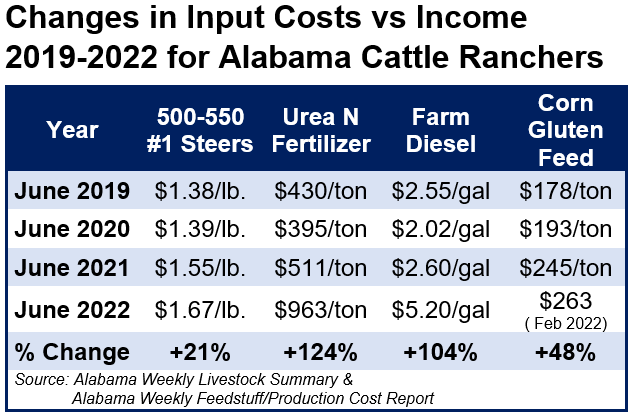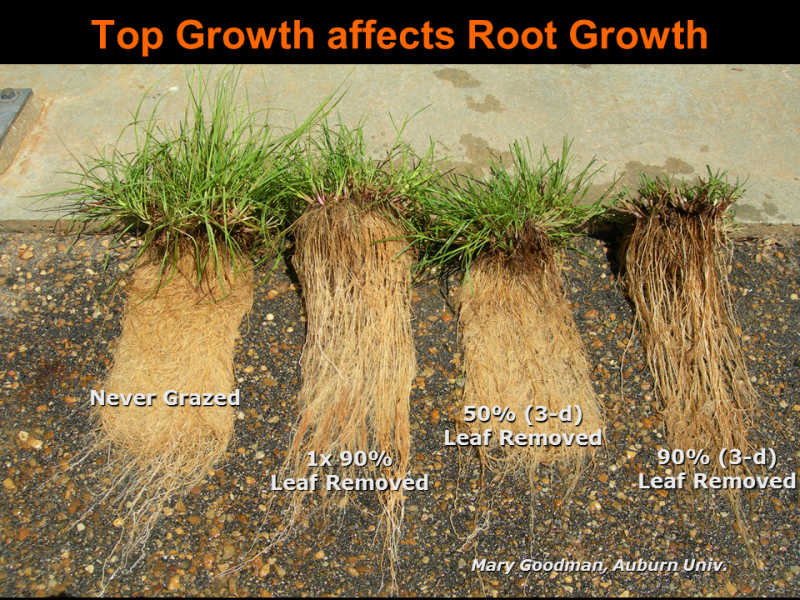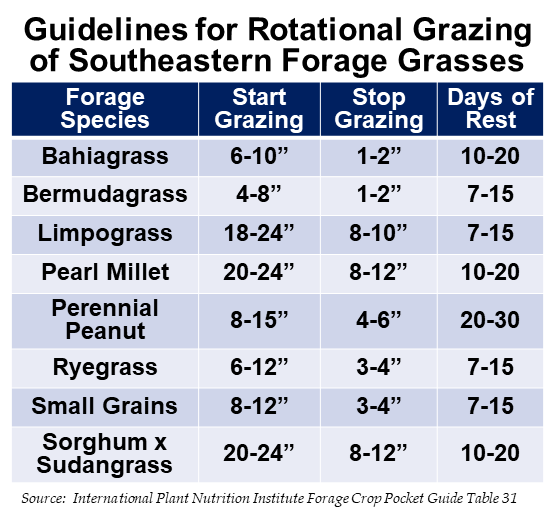As I travel around Jackson County lately I have noticed that pasture grass is in short supply on most livestock operations. The combination of flash drought (95-102° temperatures without rainfall) and little fertilization of pastures has taken its toll. To me the current grass height and growth reminds me more of late April than late June. If you missed Dr. Mackowiak’s article published last week, Impact of Limiting or Eliminating Fertilization of Bahiagrass Pastures, I would encourage you to review it. In the article she shared a summary of trial data from multiple locations that included Gulf County. In their study, by the third year, forage yield was reduced 48% without fertilization versus the complete N-P-K fertilizer control. With the combination of limited water and nutrients, it is really not that surprising that pasture grass is in short supply at this point in the season.
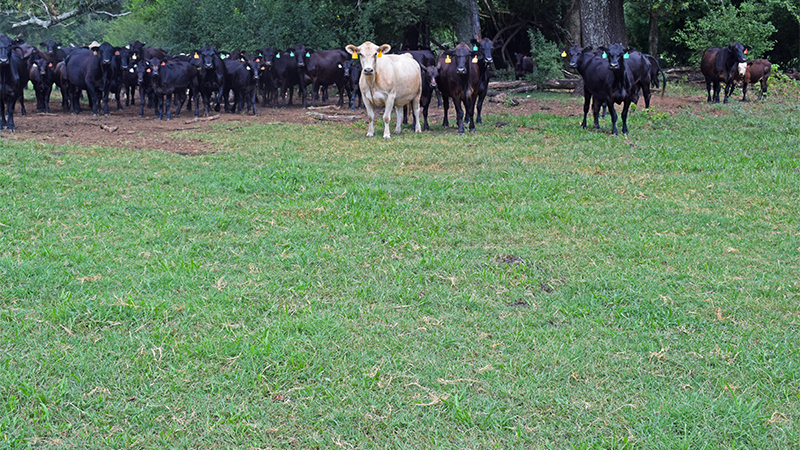
The combination of a two-week flash drought and the elimination of high cost fertilization has hampered forage growth in Jackson County pastures. Credit: Doug Mayo, UF/IFAS
–
I have always recommended bahiagrass and bermudagrass pasture and hay field fertilization, but with current input costs as compared to income (table 1 below), I fully understand the decision that most most cattle producers made to eliminate pasture fertilization this year. I receive a weekly summary from Alabama that tracks average prices for cattle sales, as well as input costs. I went back through the June reports from 2019 through 2022. In the table you can see that while income has improved 21% since 2019, production costs have soared 48-124%. Unfortunately, their weekly report stopped tracked feed-stuff costs in February, but their reports provide a good comparison of three key input costs: Urea for nitrogen (N) fertilization, farm diesel, and corn gluten feed that is commonly used for cattle supplementation.
My intent for this article is not to criticize the management decision to eliminate fertilize this year, but instead to discuss how to better manage what you have for the remainder of the growing season. There are a few tools available to make efficient use of the forage you can still produce this growing season.
–
1. Keep Grass in a Vegetative State
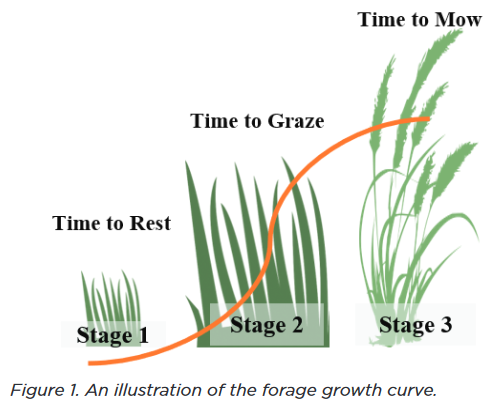
Forage Growth Curve Illustration. UT Extension’s Grazing Management Principles for Beef Cattle.
No matter what type of forage you have, your stocking rate, animal species, or how many paddocks you have, the number one goal of grazing management is to keep your forage in a vegetative or fast-growing stage that is not so short that there is not enough forage produced or too tall when it is mature and flowering. The illustration to the left, from Grazing Management Principles for Beef Cattle, appears to represent fescue, but the same principle is true for most any forage. Bahiagrass has a much different seed-head, but the same basic grazing management principle applies to all species.
Stage 1 is when the livestock should be removed to allow the forage to recover Grazing short grass over and over forces the plant to switch from growth to survival mode. Many of the pastures I have seen lately are in survival mode. If they are continuously grazed at this stage, don’t be surprised if centipede and other weeds start to take over, because the grass can’t survive under continuous stress. While the grass quality at this stage is excellent, there is not enough tonnage to keep the cows full so they have to expend a great deal of energy trying to harvest enough forage to meet their nutritional needs. In stage 1, the plant is forced to shed roots to focus energy on regrowing leaves, which are the solar panels that power the forage factory. In order to survive, leaves are more important that roots.
The photo below represents bahiagrass under different grazing systems. The plant to the left represents grass without grazing pressure. This would be representative of grass in a hay field with long regrowth periods and ample fertility. The next plant represents an intensive grazing systems where 90% of the grass is removed and then allowed to rest for three weeks. The third plant is the take half, leave half principle in good a rotational grazing system where animals come in and out of the pasture in stage 2. The final plant is one from a continuous grazing system where the plant is grazed off almost to the ground on a regular basis. You can see that the bahiagrass that is never allowed to leave stage 1 has minimized feeder root growth in order to enter what I call survivor mode. Eventually the plant gets weaker and weaker. The forage growth you can see aboveground is normally a good representation of the root system underground.
–
In Stage 2, the grass has ample stored energy for rapid growth. Notice the orange line in the forage growth curve illustration above, this represents the growth speed of the plant. In stage 1, the plants takes energy from the roots to power leaf regrowth. In Stage 2, the larger leaves are the solar panels fueling the forage factory, so the root system can also grow rapidly to reach more moisture and nutrients. Livestock that graze in Stage 2 are going to focus on the most tender leaf tips and leave the less tender stems alone. Remember the rule of thumb for grazing management – “Take Half and Leave Half.” If you remove the animals without grazing off the stems, the plant has much less rebuilding to do, so it recovers more quickly.
If you allow the grass to get mature in Stage 3, with flowers and then mature seeds, the quality will be at the lowest point with more indigestible fiber and lower protein levels. Think okra. Have you ever eaten okra that was very large and over-mature? It gets tough and stringy. Grass is the same way. With legumes this is not as great of an issue, but no mater what forage you are talking about, the flowering and mature seed production in stage 3 is the poorest quality, least digestible forage. In the mature stage there is plenty of forage for the animals to eat, but the poor quality reduces their appetite. At this point, the only option will be to force gazing with protein supplementation, or mowing or hay harvest that add extra fuel and labor costs to get back to Stage 2. Be aware that while there will be excellent yield in bales per acre, the quality of the hay will likely be significantly lower than in Stage 2. Over-mature forage is the lowest quality, because this is when the forage is “rank” or tough with a greater percentage of low digestible fiber.
But this principle is more than just what is good for the grazing animals. You have to also consider the long-term survival and the short-term productivity of the pasture. If your pastures are struggling to keep up with the herd, it is time to move cattle out of the pasture. If you have some leftover hay from winter, you can feed it in a sacrifice area or pen to allow pastures to grow back to Stage 2. If you don’t give the pasture periods of rest, expect serious declines in grass survival. This type of system favors weeds, such as common Bermudagrass, centipede grass, or dogfennel over bahiagrass.
–
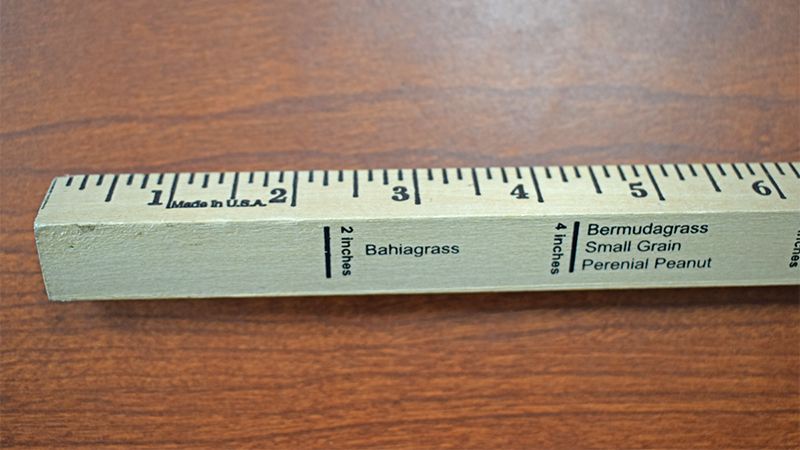
A Grazing Stick is a square yard stick that includes guidelines for starting and stopping grazing on common forage species. Credit: Doug Mayo, UF/IFAS
There is a simple tool that can help you manage to keep forages in Stage 2 called a “Grazing Stick.” A Grazing Stick is a square yard stick that includes guidelines for starting and stopping grazing on common forage species. Any yard stick or tape measure can be used to measure the forage height, the nice thing about grazing sticks is that grazing guidelines are printed on the other three sides of the stick. I could not find a place to purchase these online, but that is OK. Just purchase a solid wood or plastic yard stick and use the chart below as a guide for pasture rotation.
2. Develop a Herd Rotation System
The most challenging grazing system to manage is continuous grazing of the same pastures. The only method for management is to change the number of animal grazing to match available forage production. Most operations are not constantly buying and selling animals, so you need to develop a rotation program that provides multiple paddocks that allows rest between grazing periods. Two pasture is better than one, but five or more is better than two. You don’t have to make a huge investment in permanent fencing to make this work. Two strands of high tensile electric wire, and a strong charger with some 10′ PVC pipes cut in half can serve as fence spacers to divide an existing pasture. Once you start dividing pastures into paddocks, you do have to figure out a water source, but this is not that challenging using temporary fencing supplies. The following illustration was developed for the publication, Pastures for Profit: A guide to rotational grazing. The authors took their example to the extreme level, so I am not advocating a 64-paddock system, but the key thing to see in this example is the amount of rest provided for the paddock after grazing. This 100-acre pasture can be managed more effectively with temporary fencing and equal divisions that allow you to manage how the pasture is grazed and how much rest it receives.
–

Subdivision to eight paddocks with portable fencing. Source: Planning Fencing Systems
for Intensive Grazing Management
The illustration above shows the value of dividing pastures into grazing paddocks, but this is not practical because it over simplifies the challenges you will face. In the publication, Planning Fencing Systems for Intensive Grazing Management, they offer a better example of how an 80-acre farm might be converted from continuous grazing to an 8-paddock grazing system. With each division the animals grazing will utilize the forage more efficiently, and the forage will have more rest time for faster recovery. You have to develop a system that will work with what you already have so that your paddocks are relatively even in size and have access to water. Whether you use temporary electric fencing (cheapest option) or a combination of permanent and temporary fencing, the point is to use multiple paddocks to better manage the forage you currently have growing on your operation. There should not be a set number of grazing days for each paddock, instead use your grazing stick as a guide to ensure the forage has enough recovery time to stay in the vegetative growth Stage 2.
–
3. Reduce the Stocking Rate
Throughout my career I have advised people getting started in the cattle business to plan on having at least 2-acres of bahigrass/cow-calf pair as a minimum stocking rate. Every time I have visited an operation that has tried to push this minimum there have been problems maintaining a quality bahiagrass pastures. This standard rule-of-thumb, however, was based on annual pasture fertilization. If pastures are not fertilized, the minimum stocking rate has to be decreased. Based on current UF/IFAS studies, the stocking rate on unfertilized pasture should be more like 4-acres/cow. If you have made the tough choice to eliminate pasture fertilization, then you must follow that decision by reducing the herd. Even with a better paddock rotation system, the lower forage production has to be accounted for.
There are several ways to approach this. One of the fastest ways to boost summer forage production is early weaning of calves. Just understand that lighter calves mean lower income as well. Your 200-400 pound calves are are also grazing forage as they follow their Momas around the pasture. Weaning in July will ease the load on the forage and also reduces the nutrient requirements for cows that have been converting forages into milk production. Cows in a poorer body condition scores of 2-4 will respond fairly quickly through the summer without calves to feed. Just understand that a 200-400 lb. calf eats less than 1/3 the amount of forage as a 1200 pound cow. To truly make an impact on the stocking rate, you will have to cull mature cows from your herd. Start by pregnancy testing at weaning and selling the cows that won’t calve next fall. More than likely that will only remove 10-15% of the herd, so you are also going to have to sell older cattle too to make an impact on your current stocking rate. Use your records to sell the lower performing cows that either calved late, or produced the lightest calves at weaning. The main idea is to adjust the number of animals grazing to the point that the grass stays in stage 2.
–
4. Its Not to Late to Fertilize
Fertilizer is very expensive, as we have already discussed, but so is buying hay and feed this year. You do have to consider the issue that if there is not enough forage to feed the herd at the end of June, how much will be available in October? I am excited that the high pressure system has moved off from over the Panhandle. Rain is slowly reaching back across the area, so better days lay ahead. The challenge is to grow enough grass in the coming months to carry the herd through October. While I am not at all advocating fertilizing every acre, it is worth considering fertilizing your very best pasture. The seasonal clock is ticking however, as the longest day of the year was June 21. As the days get shorter the grass will grow slower. So if you are considering some level of fertilization to boost forage growth, I would do it soon to get the full benefit. Even if you only fertilize one acre per cow, you will grow more of your own feed. By targeting your most productive pastures you can assure the greatest return on this hefty investment.
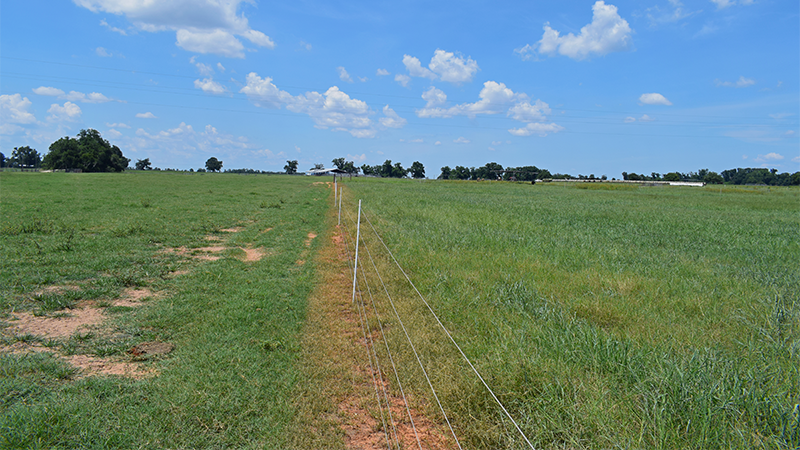
The fence divides two trials at the NFREC Beef Unit on 6/27/22. To the left is unfertilized grass with a high stocking rate for a silage feeding trial. To the right is fertilized grass with low stocking rate for a grazing trial. Neither pasture has had rainfall for the past two weeks with highs of 95-100. Credit: Doug Mayo, UF/IFAS
–
Jose Dubeux, Forage Management Specialist, North Florida Research and Education Center, in Marianna shared, “Studies have shown that for every pound of nitrogen (N) applied to tropical grasses you get ~30 lbs. of dry matter yield in return, if you have adequate moisture, pH, and other nutrients.” Using this as a guide, If you were to apply 50 units of N/acre (109 pounds/acre of 46%N Urea) you can expect 1,500 of dry feed in return. A local farm supply dealer shared this week’s local price for Urea was $740/ton ($0.37/lb.). If you include in the cost of application (~$10/acre), it would cost approximately $50/acre to fertilize with 109 lbs. of Urea for a return of 3/4 ton of feed or $67/ton, on a dry matter basis. Compare that with dry feed that must be hauled to the ranch, and the labor and fuel to feed the cows. I contacted a bulk feed distributor this week in Southeast Alabama who told me the bulk price of soy hull pellets was $265/ton. Compare that also to a $70 round bale of hay (1,000 lbs.) that is 85% moisture, or $165/ton on a dry matter basis. Yes, fertilizer is much more expensive than in year’s past, but you can still grow your own feed cheaper than you can buy it, and the cows do all of the work to harvest it, with very little waste. If you are not willing to reduce your stocking rate, you can either feed the herd with fertilized grass now or purchased extra hay and feed later this fall.
–
Take Home Message
July is here, so it is time to take some sort of action, if grass is short on your farm. Hopefully the scattered summer rains will boost grass growth once again. The days are getting shorter now, so it is vitally important to manage grazing well over the next few months to prepare for fall. Use these tools to keep the grass growing in the rapid growth phase of Stage 2. Reduce the load your pastures are being asked to feed, and they will respond. If you are going to keep the same number of cows, fertilizer may be your best purchased feed option. If you want help developing a better grazing management plan, contact your local county agent. We can request assistance from forage specialists with the expertise to develop the right grazing plan for your operation.
–
More information on this topic are available in the following publications:
Grazing Management Principles for Beef Cattle
Pastures for Profit: A guide to rotational grazing
Planning Fencing Systems for Intensive Grazing Management
Grazing Management Concepts and Practices
Impact of Grazing Methods on Forage and Cattle Production
- November 2025 Weather Summary & Winter Outlook - December 5, 2025
- Friday Feature: The History of Beekeeping - December 5, 2025
- Friday Feature:Malone Pecan Festival Tractorcade - November 21, 2025

